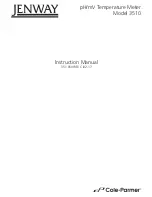
2
2.3
Do not use this meter with its case open, or with parts removed. Doing so
may damage the meter and/or injure the user.
2.4
When using this meter in schools and workshops, responsible teachers or
skilled personnel must control the usage of this meter. Failure to observe this
precaution may result in damage to the meter or injury to the user.
2.5
Follow the recommendations of any Trade Organizations or Regulatory
Agencies whose scope encompasses the use of this meter. Failure to do so
may result in damage to the meter or injury to the user.
2.6
Do not open this meter for maintenance without first disconnecting the test
leads from all external circuitry. Failure to observe this precaution may result
in damage to the meter or injury to the user.
2.7
Repairs and maintenance must only be carried out by qualified service
personnel or qualified electricians / technicians who know the dangers of,
and the safety rules applicable to this type of equipment. Failure to observe
this precaution may result in damage to the meter or injury to the user.
2.8
Always set the meter to the appropriate range or mode before connecting it
to the circuitry to be tested. Failure to observe this precaution may result in
damage to the meter or injury to the user.
2.9
Check the condition of the test leads before making a measurement. Do not
use the test leads if there is damaged insulation or exposed metal. Failure
to observe this precaution may result in damage to the meter or injury to
the user.
2.10
Make sure test leads are properly inserted and seated in the meter’s input
jacks. A loose test lead may cause the user to believe that no hazard exists,
when in fact, dangerous voltages or currents may be present. Failure to
observe this precaution may result in damage to the meter or injury to
the user.
2.11
Do not touch the tips of the test leads when making a measurement. Do not
touch live circuitry when making a measurement. Failure to observe this
precaution may result in damage to the meter or injury to the user.
2.12
Before using the meter, examine both the meter and the test leads for
damage. Do not use the meter if damage (damaged insulation, exposed
metal, cracked case, burnt smell, etc.) is evident. Failure to observe this
precaution may result in damage to the meter or injury to the user.
2.13
Insert the test leads in the jacks specified in the instructions for performing
particular tests. Inserting the test leads in incorrect jacks can damage the
meter and/or injure the user.
Downloaded from
Arrow.com.
Downloaded from
Arrow.com.
Downloaded from
Arrow.com.




































